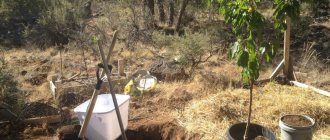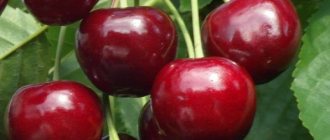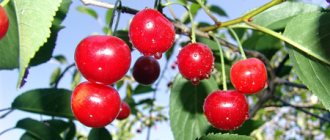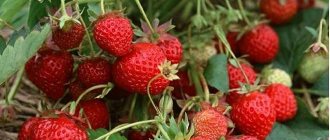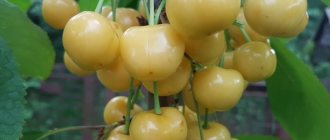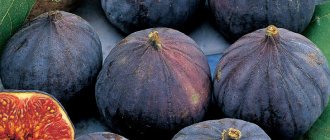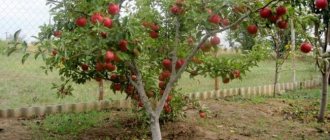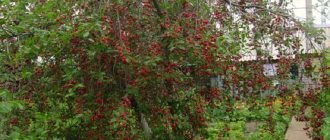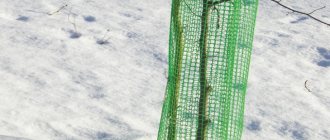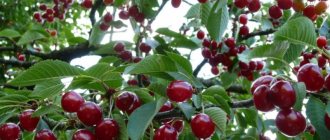Characteristics of the cherry variety Iput
Cherry Iput belongs to the mid-early early-fruiting varieties. It has good immunity to coccomycosis and klyasterosporiosis. Winter-hardy, partially self-fertile variety with average yield.
Tree
The Iput cherry tree is medium-sized. The height of an adult plant is 4-5 m. The densely leafy crown has the shape of a wide pyramid. Large buds. Cherry leaves are elongated, elliptical. The leaf blade is dark green, wavy and slightly concave. It has double-crest serration along the edges. Petiole of medium length. The flowers consist of white touching petals. The whisk is saucer-shaped. There are 3-4 flowers in an inflorescence. Fruiting is observed on bouquet branches.
Tree of the Iput variety is medium in size and has a wide-pyramidal, densely leafy crown
Fruit
The fruits of the Iput cherry are quite large - from 5 to 9 g. The shape is blunt-heart-shaped, the skin is dense, glossy. The dark red berries become almost black when fully ripe. The sweet, juicy pulp is of medium density.
Tasting score – 4.6 out of 5 points.
The average weight of berries of the Iput variety is 7 g
Useful material
Iput cherries are very tasty and juicy. Their sweet pulp contains many vitamins and minerals.
| Element | Substance content per 100 g |
| The nutritional value | |
| Calorie content | 52 kcal |
| Carbohydrates | 10.8 g |
| Squirrels | 1.1 g |
| Fats | 0.4 g |
| Alimentary fiber | 1.1 g |
| Organic acids | 0.5 g |
| Sahara | 11 g |
| Solids | 16.6 g |
| Vitamins | |
| Vitamin A (VE) | 0.25 mg |
| Vitamin PP | 0.5 mg |
| Vitamin B1 (thiamine) | 0.01 mg |
| Vitamin B2 (riboflavin) | 0.01 mg |
| Vitamin E (TE) | 0.3 mg |
| Vitamin C (ascorbic acid) | 10.5 mg |
| Macronutrients | |
| Calcium | 33 mg |
| Magnesium | 24 mg |
| Sodium | 13 mg |
| Phosphorus | 28 mg |
| Microelements | |
| Iron | 1.8 mg |
Advantages and disadvantages
The main advantages of the Iput cherry variety include:
- annual high harvest;
- earlier maturation;
- resistance to fungal diseases;
- high winter hardiness of flower buds.
Disadvantages of the variety:
- average precociousness (begins to bear fruit at 4-5 years);
- the bone is difficult to separate from the pulp;
- If there is excess moisture, the berries will crack.
Iput cherry fruits are rich in vitamins and minerals
Comparison of Iput cherries with other varieties (table)
| And the way | Ariadne | Revna | |
| Ripening time | early | early | average |
| Resistance to coccomycosis | high | average | low |
| Berry weight | 5-9 g | 4-6 g | 4-7 g |
| Pulp | sweet, dense structure | sweet, soft texture | sweet, dense structure |
| Productivity (kg per tree) | 25-35 | 10-15 | 15-20 |
| Pollination | partially self-fertile | partially self-fertile | self-sterile |
History of selection
Scientists breeders of the Bryansk Research Institute named after. Lupine, gave the world many new unique varieties of fruit and berry crops.
The end of the last century turned out to be especially fruitful, when the union of famous scientists Astakhov and Kanshina, as a result of lengthy experiments, obtained frost-resistant varieties of cherries bred for cultivation in temperate and cold climates.
One of these developments is the high-yielding and frost-resistant cherry variety Iput, named after the river flowing in the Bryansk region.
In 1993, the new fruit crop was entered into state registers.
Do we need pollinators?
Cherry Iput is a partially self-fertile variety. For a good ovary, cherries must be artificially pollinated or planted next to varieties such as Tyutchevka, Revna, Ovstuzhenka, Raditsa, Bryanskaya rozovaya.
The best pollinators for Iput cherries (photo gallery)
Tyutchevka fruits are large and dense
Rhubarb trees are stunted, the fruits are large and sweet
Raditsa fruits do not crack and ripen early
The Ovstuzhenka variety is characterized by early fruit ripening and high resistance to coccomycosis and moniliosis.
Bryansk pink - winter-hardy and high-yielding variety
Landing
Young trees are planted in the spring (before the buds swell) or in the fall (after leaf fall). Planting is carried out in calm, dry weather at above-zero temperatures.
In the northern regions, trees can be planted in spring and autumn. Autumn planting is favorable for the southern regions.
Selection of seedlings
It is best to buy seedlings immediately before planting a tree - in spring or autumn. For industrial production, trees with a tall trunk of up to 2 meters are suitable, for private gardening - with a height of up to 50 cm. It is recommended to purchase zoned seedlings of two years of age.
Healthy plant parameters:
- developed crown;
- the presence of 3-4 branches 35-45 cm long;
- trunk diameter is at least 1.6 cm;
- the trunk and bark should be smooth, without swelling, spots, or growths;
- the root system is well developed; when cut, the root should have a creamy tint;
- The scion and rootstock at the grafting site should clearly stand out from each other.
Important! You should not purchase seedlings with wrinkled bark. This indicates that the plant is overdried. Such trees usually do not take root.
If the cherry seedling has dried out a little during transportation, immerse it in water for 6-10 hours after pruning the roots.
Choosing a landing site
Sweet cherries grow best in loose soils with good drainage. An illuminated area with medium loamy and loamy soil, with an acidity of at least 5.5 pH, is ideal. It is necessary to avoid places with constant flooding and stagnant moisture. The groundwater level must be at least 2 m.
Soil preparation
There are two options:
- The planting site is prepared 4-6 months before planting the seedling. A pit measuring 1x1 meter and 80 cm deep is formed. The excavated soil is mixed with 4-5 buckets of fresh compost, humus or manure and 250 g of superphosphate. The hole is immediately filled with the resulting soil mixture.
- The planting pit is prepared 2 weeks before planting the tree. In this case, half of the excavated soil is mixed with two buckets of rotted compost or non-acidic peat, 50 g of potassium sulfur, 300 g of wood ash. The mixture is placed at the bottom of the hole, and the remaining soil is poured on top.
The walls of the planting pit must be vertical (without narrowing downward)
Step-by-step description of the process
Before planting, cut off all damaged branches and roots on the seedling.
- A depression of about 80 cm is dug in the prepared hole.
- A small mound is formed from the soil at the bottom and a wooden stake is placed in it.
- The seedling is lowered into the hole and the roots are carefully straightened. The root collar should rise above the level of the site by 6-8 cm.
- The hole is carefully filled with soil and the soil is lightly compacted.
- The seedling is tied to a peg with twine.
- A hole with a soil edge is formed.
- Water the seedling with 30-40 liters of water.
- After moisture is absorbed, the hole is mulched with peat, fresh soil or wood shavings.
For good tree development, the following planting scheme should be followed:
- leave 3-4 m between trees;
- between rows - 5 m.
It is not advisable to plant cherries between apple and pear trees. This type of planting prevents cross-pollination.
Top dressing
The fertilizers that were applied to Iput during planting are usually enough for 3 years. From the second year of the seedling’s life, they begin to add urea. 100 g of fertilizer are evenly scattered over the surface of the trunk sector, and then buried 10-15 cm deep. It is also recommended to dilute 30 g of urea in a bucket of water and water the soil around the tree with this solution three times from May to the first ten days of June.
By the 4th year of Iput’s life, the root system grows widely and extends beyond the boundaries of the trunk sector. A shallow groove is dug around the plant, into which 0.15-0.2 kg of urea is added and water is poured in at the beginning of spring. At the end of summer - beginning of autumn, 300-400 g of superphosphate and 100-120 g of potassium sulfate are added to the same groove.
In the 5th year of tree cultivation in the spring, ammophoska (30 g/10 l of water) is applied under Iput. In the autumn, the soil is dug up, adding organic fertilizers:
- straw;
- humus;
- grass;
- peat;
- compost.
Feeding with compost
When the tree begins to bear fruit in early spring, you need to pour 200 g of urea into the hole around the tree, and in the fall - 30 g of potassium salt and 40 g of superphosphate.
Ciliate slipper. Description, features, structure and reproduction of the ciliate slipper
Once every 5 years, liming is carried out, during which the soil is enriched with calcium and magnesium. The minerals used in this case do not combine well with organic matter and nitrogen fertilizers.
Care
Systematic and proper care contributes to good tree development, high productivity and prolongation of fruiting.
How to care for the hole?
The diameter of the hole in an adult tree is 1 m. The tree trunk area must be cleared of weeds and overgrowth. The soil in the hole is periodically loosened and mulched with fresh soil.
Watering
It is necessary to water cherries moderately, as excess moisture leads to cracking of the berries. The soil is moistened once a month, and in case of severe drought - once a week. For a young tree, 30-40 liters of water is enough, for an adult - 60 liters.
Trimming
Cherry trees are pruned in early spring (before the buds begin to swell). From the second year after planting, a sparsely tiered crown is formed:
- The first tier consists of three main branches located at a level of 60 cm from the ground and at a distance of 15-20 cm from each other. The rest are cut in half or removed completely.
- The second tier, consisting of two skeletal branches, is formed a year later at a distance of 50-60 cm from the first.
- After 30-40 cm from the second one, one branch is left. The trunk that rises above it is cut into a ring after a year.
- In the first 5 years the tree produces very long growths. They are cut off, leaving a length of no more than 50 cm.
Formation of a sparsely-tiered crown of cherry
Pruning an adult plant consists of thinning the crown and rejuvenating the tree.
- Remove branches that grow inward and form sharp corners.
- If the annual growth is less than 20 cm, then the branches are shortened to five-year-old wood. Anti-aging pruning is carried out in stages over two years.
- During fruiting, diseased, broken branches are removed. In addition, the growth of the central conductor and skeletal branches is restrained, transferring them to lateral shoots.
Preparing for winter
To prevent the negative effects of low temperatures, the trunk of young cherries is whitened, wrapped in burlap, and covered with spruce branches or roofing felt. In regions with severe frosts, the crown is covered with light lutrasil.
Mature trees are whitewashed, and a layer of peat or wood shavings is poured onto the tree trunk area.
How to whitewash trees (video)
Top dressing
To fully saturate the cherries with the necessary substances, the tree is regularly fed.
| Season | Type of feeding | Period | Facilities |
| Spring | root | before flowering (April) | When digging a circle around the trunk, 20-30 g of ammonium nitrate are evenly scattered per 1 square meter. m plot. |
| during flowering (May) | The mineral solution is prepared in the following proportion: 20 g of urea per 10 liters of water. Water at the rate of 5 liters per tree. | ||
| after flowering | Chicken manure solution: add 1-1.5 kg of dry chicken manure to a bucket of water. Leave for 1-2 days. One tree requires 2 liters of liquid. | ||
| Summer | foliar | June 15-30 | Solutions containing potassium and phosphorus. “Nitroammofoska”, potassium chloride, potash, “Ammophos”, potassium monophosphate. Prepare according to instructions. |
| Autumn | root | end of September | A layer of peat, humus or compost 3-7 cm thick is placed on the hole. |
| Soil liming is carried out using lime, chalk, and ash. Raw materials are selected depending on the type of soil. The solution is poured under the tree once every 5 years. |
Root feeding of young trees is carried out annually upon reaching the age of seven. Adult plants (over 12 years old) are fertilized once every 2-3 years.
Important! When feeding, you cannot use mineral and organic fertilizers at the same time.
Often, liquid fertilizers are applied to special holes dug in the tree trunk. Their depth is about 30 cm. Recesses are formed throughout the entire territory of the trunk circle
Protection from diseases and pests
Timely treatment of cherries from diseases and pests will prevent crop loss and preserve the integrity of the garden.
Preparations for protecting cherries from pests (table)
| Period | Pests | Facilities | Prevention |
| Before flowering |
| Zolon, Nexion, Ambush, Chlorophos - 1 time in March. |
|
| goldentail | Karbofos solution 0.3% - once in April. | ||
| ticks | Anti-mite, Tsifoks - sprayed 2-3 times every 10 days. | ||
| After flowering | tube gun | Karbofos solution 7% or Trichlorometaphos-3. Spray 2 times with an interval of 7 days. |
|
| ticks | Sumition, Pirinex - sprayed twice with an interval of 14 days. | ||
| Growing season |
| Fufanon, Karbofos, Metafosom - 1 time. If the pest is not destroyed, the procedure is repeated after 15 days. |
|
| ticks | Aktelik - sprayed twice with an interval of 15 days. | ||
| cherry fly | Diazinon, Phosfamide - sprayed during the period of fly attack and egg laying (late May and mid-July). | ||
| After harvest and after leaf fall | rodents | Clean house, Storm. Briquettes or granules are placed in holes or in special baits. | Rodents are repelled by wood ash and peat chips, sawdust soaked in creolin or kerosene, scattered in the tree trunk. |
| cherry slimy sawfly | Cyanox, Gardona, Karbofos - once. | Digging and loosening the soil around tree trunks. | |
| winter moth | Treatment of the lower part of the trunk with Nitrafen. | Timely removal of moss from tree bark, whitewashing of trunks. |
After spraying, the soil in the circle around the trunk is dug up or loosened.
Remedies for protection against diseases (table)
| Period | Diseases | Facilities | Prevention |
| Before flowering |
| Nitrafen, copper sulfate solution 1%, Topaz, Fitosporin - sprayed twice with an interval of 10-12 days. |
|
| Clusterosporiasis | Nitrafen, copper sulfate 1% - once. | ||
| sulfur-yellow tinder fungus | Antifungal whitewashing of the trunk and lower skeletal branches, treatment of wounds on the bark with a solution of 3% copper sulfate or garden pitch. | ||
| After flowering |
|
|
|
| Clusterosporiasis | Bordeaux mixture 1%. Spray twice with an interval of 15-20 days. | ||
| sulfur-yellow tinder fungus | In July, cut off the polypores and treat the wounds with 1% copper sulfate. If the tree is severely damaged, it is uprooted and burned. | ||
| Growing season | brown spot | Bordeaux mixture 5% - once. |
|
| Horus, Fitosporin - twice with an interval of 7-10 days. |
During preventive treatment, only one chemical agent is used; several chemical agents cannot be used simultaneously.
The last insecticidal treatment is carried out 20-30 days before harvest.
Diseases and pests
Iput cherry has good resistance to fungal diseases, but can be attacked by insect pests.
Table: pest and disease control measures
| Diseases and pests | How do they manifest themselves? | How to prevent | How to fight |
| cherry fly | A small insect whose larvae eat the fruit. Cherry berries become soft and darken quickly. Pits form on them due to passages eaten inside. The fruits rot and begin to fall off. |
|
|
| Winter moth | Nondescript beige moths. They appear 2 weeks before flowering, feeding on leaves and young shoots. The moth caterpillar eats buds, flowers, ovaries, entwining everything with a web. | Treat before flowering with Confidor, Actellik, Aktara (according to instructions). | |
| Black cherry aphid | Aphids settle on shoots or the underside of leaves and begin to feed on their juice. Such leaves wrinkle, darken, and dry out. |
| Treat with Iskra, Fitoverm, Komandor (according to instructions). |
| Cherry shoot moth | Caterpillars damage buds that have not yet bloomed, causing their death or the appearance of deformed leaves. After this, the caterpillars move on to the shoots and flowers, eating away the stamens and pistils. The ovary is not formed. |
|
|
| Mosaic cherry disease | A disease that attacks the leaves of a tree. Yellow stripes appear along the veins, the leaf curls, darkens and falls off. | The spread of this virus is facilitated by aphids and mites, so control of these insects will be a preventative measure. | Viral diseases are practically untreatable. |
| Gum treatment | Frozen glassy discharge on the trunk. |
|
|
Photo gallery: pests and diseases
Cherry fly larvae eat up cherry fruits. Moth caterpillars eat flowers and ovaries, entwining everything with cobwebs.
Black cherry aphid forms colonies on the underside of the leaf
When gum disease occurs, “glass” growths form on the trunk. Mosaic disease is practically impossible to cure
Features of fruiting
Cherry Iput is a mid-early variety. The berries ripen in early June. Fruiting begins 4-5 years after planting. The average yield of one tree is 25 kg. With good care and favorable conditions, you can collect more than 30 kg of juicy berries from one cherry.
The Iput variety has a small peculiarity - cherries grow in small bouquets, so they are very convenient to pick.
The fruits are stored in the refrigerator for no more than 5 days. Cherries are consumed fresh, and are also used for preparing seasonal preparations, wine, juices, jams, and confitures.
Iput cherry fruits are great for preparing various winter preparations
Reviews from gardeners
From successful cultivation and good fruiting, I currently know Iput and Revna, they are planted together, since cherries are self-sterile, and these varieties are mutually pollinating. But even the perfectly growing, frost-free and fruit-bearing cherry tree has a big disadvantage - it grows as a tall thin tree (it’s problematic to lean a ladder against it), which means it needs shaping. This is what happened to my friends in the Leningrad region: excellent harvests (without shaping), gorgeous berries, but all of them go to the birds.
stounns
https://www.tomat-pomidor.com/newforum/index.php?topic=2109.0
My Iput was planted as a two-year-old in March 2011. It overwintered well. Only one branch was a little frozen, but it has now completely recovered. The frosts remained -32 Celsius for a week. Lungwort was planted nearby - it froze completely, up to the level of the snow.
Besik
https://forum.prihoz.ru/viewtopic.php?f=37&t=253&start=750
We took our current Iput in March 2011 as a two-year-old with a closed root system; it grew well over the past summer, the branches practically did not freeze in winter.
Anina
https://forum.prihoz.ru/viewtopic.php?f=37&t=253&sid=abec7cb5e6e124f3ef89496d94abc0f2&start=735
Iput turned out to be the most delicious and largest, bearing fruit in the 3rd year. It grows very quickly, this year the growth is almost a meter high. Our Iput is not dark red, but simply red, maybe it doesn’t have enough sun. By the way, birds also like cherries.
GRUNYA
https://dacha.wcb.ru/lofiversion/index.php?t22817.html
We have had Iput cherries for the 3rd year now. Semyonovsky district, winters well.
Charlie77
https://www.nn.ru/community/dom/dacha/?do=read&thread=2255874&topic_id=50067776&year=2012
Juicy, sweet, large berries are not the only advantage of Iput cherries. Frost resistance, ease of care and high yield explain the constant demand for this crop and allow the use of cherry fruits and seedlings in commercial activities.
- Author: Anna Gradskaya
The desire to learn something new every day helps improve professional skills. Rate this article:
- 5
- 4
- 3
- 2
- 1
(7 votes, average: 4.1 out of 5)
Share with your friends!
